Kale can be steamed, sautéed, boiled, and simmered. Kale can be tenderized and served in salads or combined with potatoes to make a tasty soup. Kale is a great match with hearty foods such as pork chops, fried catfish, garlicky sausage, and cornbread.
Kale can be prepared just as you would spinach. It should not be overcooked otherwise it will lose its hearty flavor and texture. Cook kale until it is just tender, usually 5 minutes or less. To moderate the strong flavor and fibrous texture of some kale, you can blanch kale for 5 minutes before cooking depending upon the toughness of the green.
Also of interest:
Kale is usually cooked and rarely eaten raw because of its strong pungent flavor. Small amounts of raw, young kale can be added to salads to bring a spicy note. Steam kale and serve with butter, lemon juice, and chopped bacon.
Kale has large cabbage-like curled leaves, usually soft green but also shades of blue-green and variegated shadings from red to white and yellow to white. Curly-leafed kales form compact clusters of tightly curled leaves.

A winter vegetable that goes practically undisturbed even by snow, kale can come freshly harvested to the table in mid-winter in even the most severe climates.

How to choose kale
- Select kale with fresh, plump, crisp leaves.
- Avoid kale with limp or yellow leaves.
- Sniff the leaves and avoid those with a strong odor.
How to store kale
- Kale will keep in the coldest section of the refrigerator for 2 days. After 3 days of keeping, the flavor of kale will become strong and the leaves will go limp.
- Kale can be frozen after being blanched for 2 to 3 minutes or until the leaves become slightly soft.
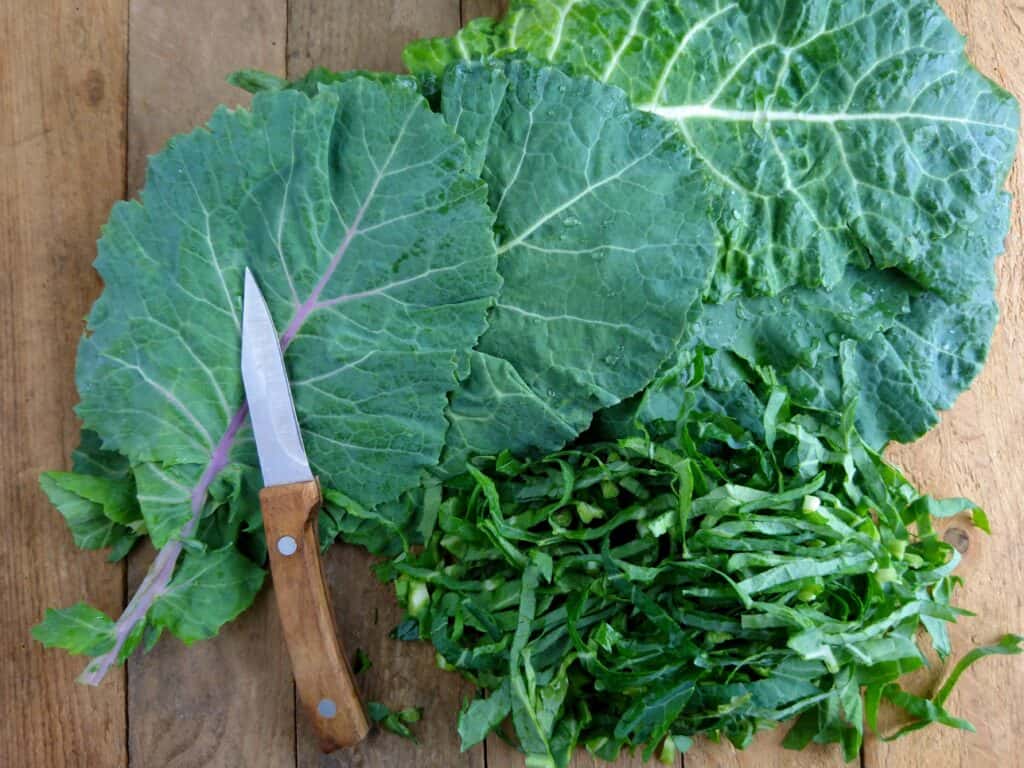
How to prepare kale
- Before cooking, remove the tough center stalk by folding the leaves in half and ripping the stalk out.
- Wash the leaves in a large bowl of water to dislodge sand and dirt. You can add vinegar or salt to the water to dislodge any insects. Afterward, rinse the leaves under cold running water.
- Don’t dry the leaves before cooking. Use the residual water on the leaves to help wilt the leaves as they cook.
- One pound of kale with stems will serve 2 to 3 people. Without stems, one pound will serve 3 to 4 people.
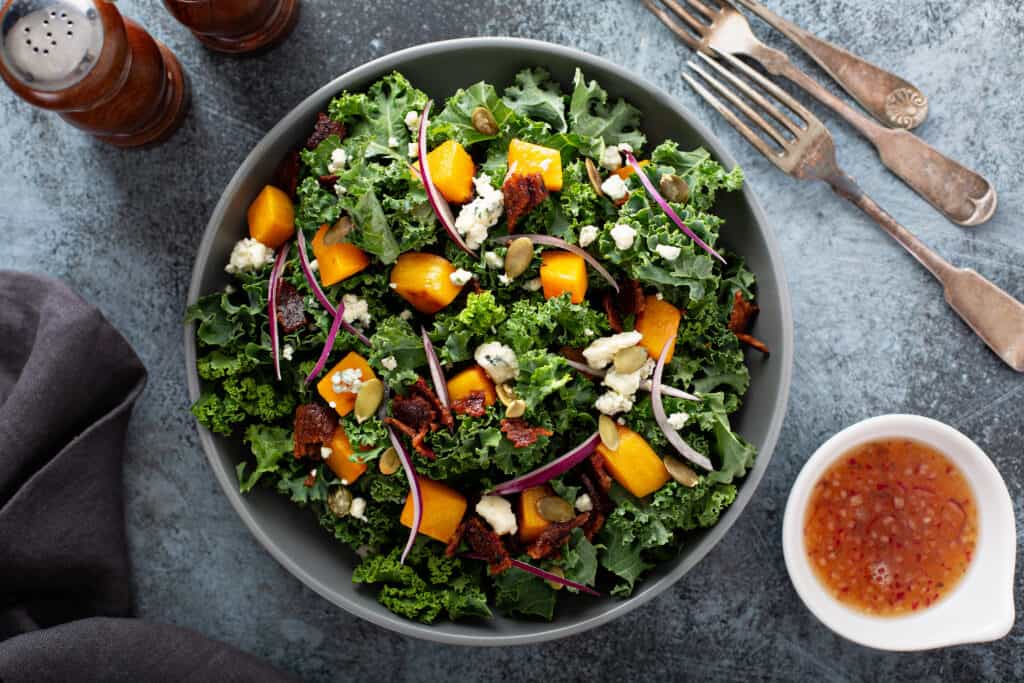
How to make kale salad
- Tenderize kale with salt before including in a salad.
- Rinse the kale then remove stems that are greater than ¼ inch across.
- Cut the leaves crosswise into ¼ inch strips.
- Sprinkle the leaves with salt and then tenderize (squeeze) them with your hands until moisture begins to sweat out. (Be careful not to add too much salt; taste the leaves to be sure they don’t become salty.
- In a large bowl, mix the leaves with a few tablespoons each of lemon juice and honey; add lemon juice and honey to taste.
- Now the kale is ready to serve, but before you do add slices of any of the following: radishes, avocado, cucumbers, squash, onions, apples, pears, oranges, apricots or raisins, dried cranberries, sun-dried tomatoes, minced shallots, sunflower seeds or nuts.
Kale cooking suggestions
- Kale has tough stems that are edible only when young. The stems of mature kale must be removed before cooking.
- Kale can be prepared just as you would spinach.
- Steam the leaves in just the water that remains after they have been washed. Steam only long enough for the leaves to wilt: 3 to 6 minutes.
- Italians steam the kale until tender, then add olive oil, a little garlic, breadcrumbs, and sprinkle it with Parmesan cheese in the last minute or two of cooking.
- The Chinese stir-fry kale with a few slices of fresh ginger root, about 1 minute.
- The strong flavor of kale goes well in soups and stews. In India, kale is often teamed with hot spices.
- Kale is rarely eaten raw because of its strong pungent flavor. Small amounts of raw, young kale can be added to salads to add a spicy note. Young kale can be dressed with oil and vinegar.
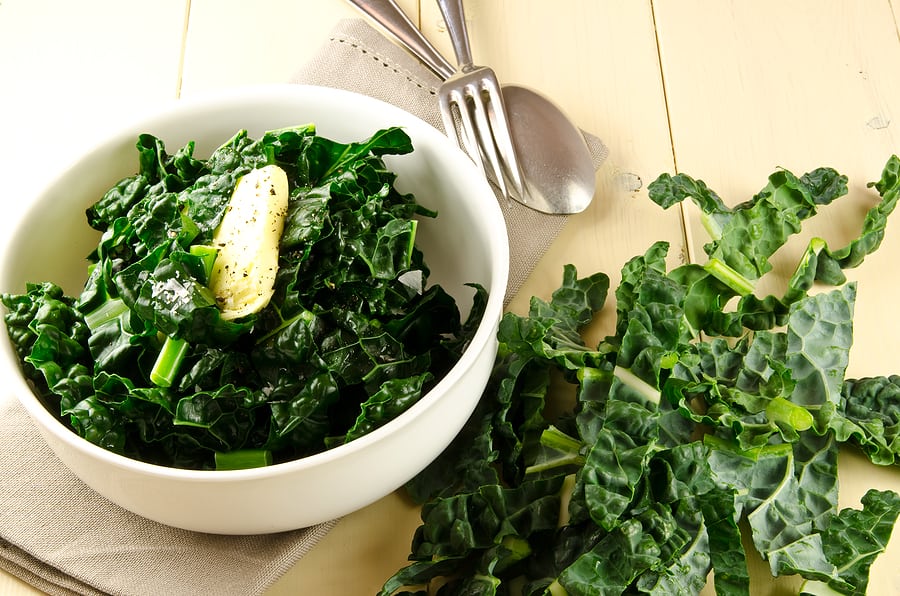
How to steam kale
Italians steam kale until tender, then add olive oil, a little garlic, and breadcrumbs, and sprinkle with Parmesan cheese in the last minute or two of cooking.
Place 1 to 2 inches of water in the bottom of a pot and bring to a rapid boil. Place the kale in the steamer basket. Turn the heat under the boiling water to medium. Place the kale in the steamer basket in the pot and cover it with a tight-fitting lid. Cook with the lid on for 2-5 minutes.
- Add a few inches of water to a pot then insert a steamer basket. The water should not touch the bottom of the steamer basket.
- Bring the water to a simmer over medium-high heat.
- Add sliced or kale cabbage and cover.
- Steam for 4 to 5 minutes, until tender.
How to quickly boil kale
- Remove stems that are thicker than ¼ inch and wash well.
- Coarsely chop the stems and leaves.
- Bring a large pot of lightly salted water to a boil.
- Cook until the leaves are tender and about 5 to 10 minutes
- Drain and serve immediately or plunge into ice water and drain to reheat later.
- Serve hot with butter, olive oil, or vinegar and a spritz of lemon.
How to simmer kale
- Remove stems that are thicker than ¼ inch and wash well.
- Coarsely chop the stems and leaves.
- Lightly coat the bottom of a deep saucepan with olive oil and set over medium heat.
- Add seasonings: onions, sliced garlic, bits of chili pepper, or salt and pepper to taste for 1 minute.
- Add the kale and a half cup of vegetable or chicken stock or water.
- Cover and cook until the greens are just wilted, about 5 minutes
- Uncover and cook until the liquid has just evaporated and the leaves are tender.
- Season again to taste and serve hot.
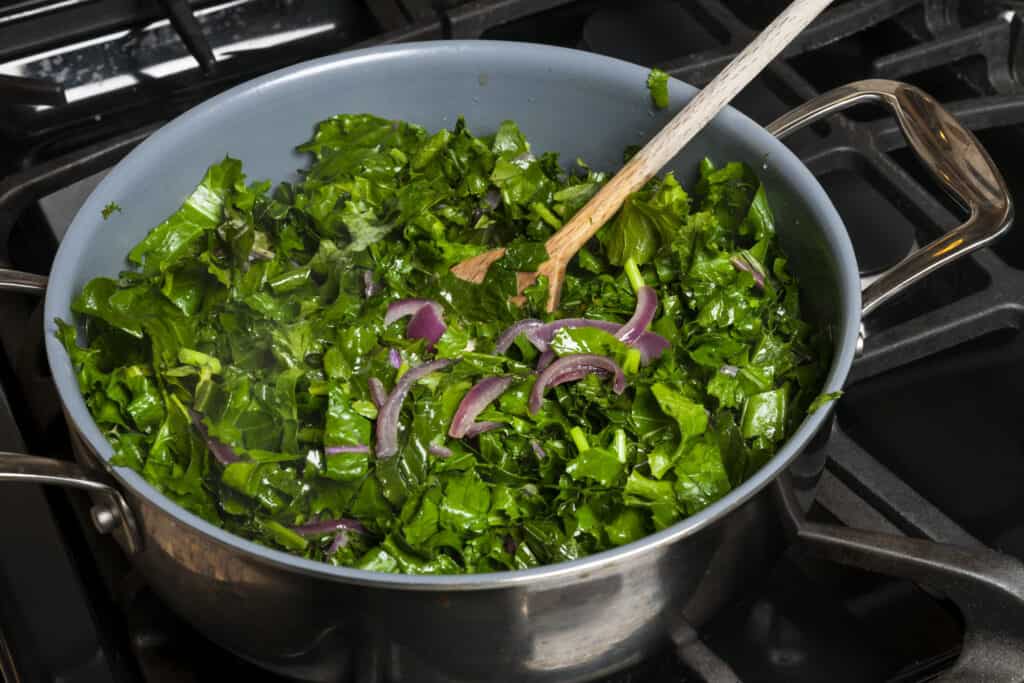
How to sauté kale
- Remove stems that are thicker than ¼ inch and wash well.
- Coarsely chop the stems and leaves.
- Heat a skillet or wok over high heat.
- Add a few tablespoons of olive or peanut oil.
- Add the leaves and a bit of minced garlic and cook over high heat stirring constantly until the leaves wilt, about 3 to 6 minutes depending on the heat.
- Season with salt and pepper and add lemon juice or vinegar to taste.
- Serve hot.
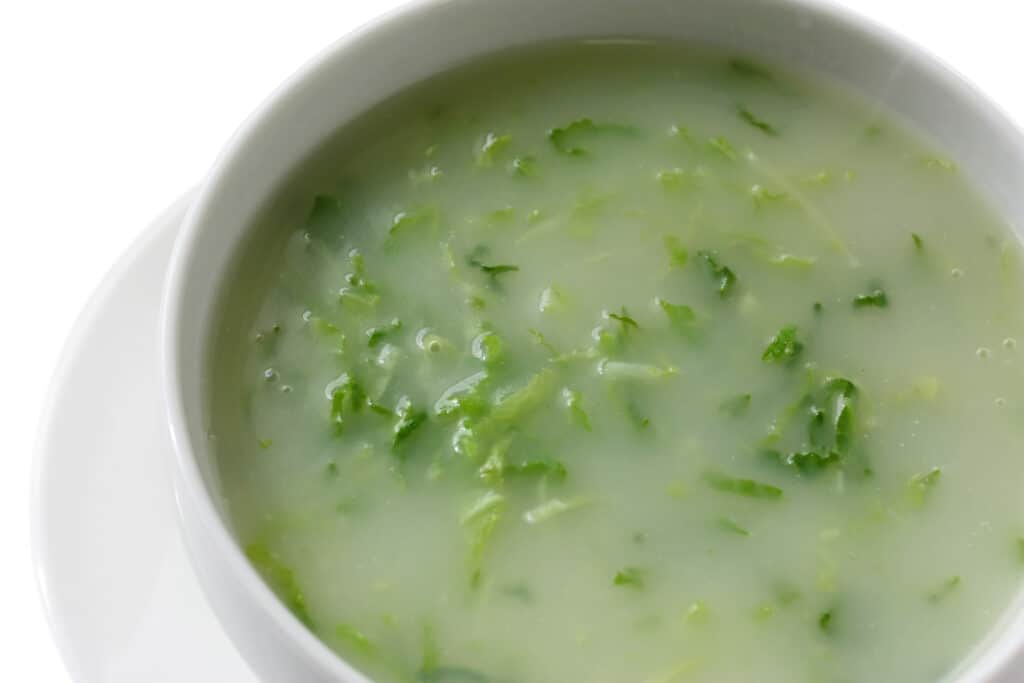
How to make kale and potato soup
This soup is known as caldo verde (green broth) in Portugal.
- Remove the stems from the kale and cut them into strips.
- Peel boiling potatoes and chop them finely.
- Bring 2 quarts of lightly salted water to a boil.
- Add the chopped potatoes, return to a boil, and cook covered for about 2 minutes.
- Add the kale and cook an additional 2 minutes.
- Season to taste with salt and pepper.
- Serve hot; a slice of sausage is often floated on top.
How to prepare Russsian red kale
Russian Red kale is thick, juicy, and chewy. Match this kale with grilled sausages, pork, or turkey. You can also match Russian Red with grains, roots, dried fruits, and nuts.
Russian Red has silvery-green to blue-gray leaves that look like a cross between a turnip green and a highly lobed oak leaf. This kale doesn’t have the frills of the curly kale or the deep-folded crinkles of Tuscan kale. It’s flat and the lobes reach almost to the stem.
You’ll find Russian Red more magenta to ruby red about the veins, particularly in early spring. That’s what cold weather will do to this kale. When the weather moderates, you’ll find Russian Red more gray or green than red. Either way, after cooking this kale turns deep green.
Don’t expect Russian Red to be tender when harvested young like other kale. From the get-go Russian Red leaves are chewy. Don’t even think about sinking your teeth into the stems.
Here’s how to prepare Russian Red: strip out the mature stems, no amount of cooking will soften them. Hold the lower leaf base up in one hand and pull the stem downward with the other. Simply strip away the leaf. Be sure to rinse the leaf pieces.
Blanch Russian Red in salted water, drain then sauté. Sauté this kale in olive or nut oil, butter, bacon, or pancetta. You can season with olives, garlic, chili, cumin, caraway, fennel, anise, or toasted sesame oil. If you want a stronger flavor, braise Russian Red in stock. Cook until tender, but remember this kale is not going to melt in your mouth like curly kale.
The very smallest Russian Red leaves can be used as a garnish or in a salad. Once the stems are stripped away the highly lobed leaves offer less leaf surface than other kales.
Similar cultivars to Russian Red are Siberian, Ragged Jack, White Russian, Red Ursa, and Winter Red.
The botanical name for Russian Red is Brassica napus, Paularia Group.
Kale flavor partners
- Kale can be seasoned with salt, pepper, onion, garlic, basil, dill, mace, nutmeg, allspice, mustard, parsley, sage, rosemary, or thyme
Kale nutrition
- Kale provides ample amounts of vitamins A and C, folic acid, calcium, and iron.
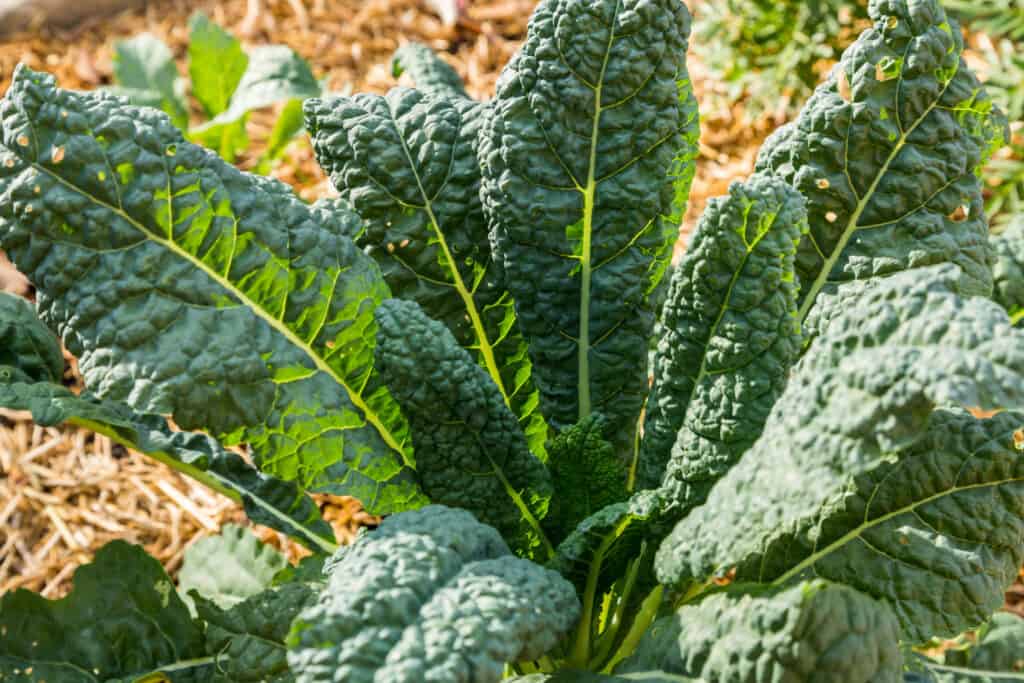
Kale harvest
Kale is harvested from autumn to mid-spring, 55 to 75 days after direct seeding. In mild-winter regions where there is no snow on the ground, kale can be grown in the garden through the winter for winter harvest. In snowy regions, kale is hardy enough to stay in the garden with the protection of row covers.
Kale leaves are the best eating when they are 8 to 10 inches (20-25 cm) long. Individual outside leaves are best when young and tender. Inside leaves are generally tastier than outside leaves. The flavor of kale is actually enhanced when the plant is touched by frost.
Spring kale can be tender. The roots of harvested kale that are left in place will sprout new heads in one or two weeks. “Cut and come again” is the term for leaf vegetables that can be brought to harvest more than once. Spring kale is often the new growth of plants sown last autumn. New, tender growth can go directly into salads.
Kale varieties
Tall kale varieties are ‘Lacinato’, ‘Toscano’, and ‘Red Russian’. Compact kale with curly leaves includes ‘Dwarf Blue Curled Vates’ and ‘Dwarf Siberian’. The frilly kale used for garnishes includes ‘Winterbor’, with green leaves, and ‘Redbor’, with purple leaves.
Get to know kale
A related plant to kale is Portuguese kale or Scotch kale, also known as curly kale. This is a short-lived perennial with a single or branched stem with broad, oblong leaves that have crispy margins. Portuguese kale leaves are used in soups and as vegetable dishes.
Kale was grown by the Greeks and Romans. Kale arrived in northern Europe in the sixteenth century and from there traveled to North America.
The botanical name for kale is Brassica oleracea var. acephala. The botanical name of Portuguese or curly kale is B. o. var. sabellica.
- The leaves of curly kale are arranged in a bouquet-like fashion. They grow from 12 to 16 inches (30-41 cm) long and are deep-green-tinged with shades of blue or purple.
- Kale is a non-heading member of the cabbage family—very similar to collards except with a differently shaped leaf.
- Curly-leaved kale varieties—sometimes called curly kale or borecole–are the most commonly eaten. Flat-leaved or plain kale varieties are too coarse and rigid to enjoy at the table.
- Kale originated in the Mediterranean region and has been in cultivation for more than 2,000 years. The name kale is derived from the Greek kaulos, meaning stem.
- From the late Middle Ages, kale was known as cole or colewort in England. Kale or kail is the Scottish name.
- The French call kale chou frisé (curly cabbage); the Germans call it krauskohl (crispy cabbage); the Italians call it cavalo arricciato (curled cabbage); and the Spanish call kale col rizada (curly cabbage).
The botanical name for kale is Brassica oleracea var. acephala. (The Latin term for “without a head” is alcephala.)
Kale articles on Harvest to Table:
More kitchen tips:
Bring your harvest to the table. Kitchen prep tips and easy recipes for the vegetables you grow. Click below for vegetable prep and recipes you can use now.
- Almonds
- Apples
- Apricot
- Aprium
- Artichoke
- Arugula
- Asparagus
- Avocado
- Bamboo Shoots
- Banana
- Basil
- Beans, Dried
- Beans. Long
- Beans, Shell
- Beans, Snap
- Beets
- Bitter Melon
- Blackberry
- Bok Choy
- Broccoli
- Broccoli Raab
- Brussels Sprouts
- Cabbage
- Cardoon
- Carrots
- Cauliflower
- Celeriac
- Celery
- Chard
- Chayote Squash
- Cherimoya
- Cherries
- Chestnut
- Chickpea
- Chinese Cabbage
- Chives
- Cilantro
- Citron
- Clementine
- Collards
- Coriander
- Corn, Sweet
- Corn, Baby
- Corn Salad, Mache
- Cranberry
- Cress
- Cucumber
- Daikon
- Dandelion
- Dill
- Eggplant
- Endive, Belgian
- Endive and Escarole
- Fava Beans
- Fig
- Florence Fennel
- Garlic
- Ginger
- Grapefruit
- Grapes
- Guava
- Horseradish
- Jerusalem Artichoke
- Jicama
- Jujube
- Kale
- Kiwifruit
- Kohlrabi
- Kumquat
- Leeks
- Lemongrass
- Lemons
- Lettuce
- Lime
- Mache (Corn Salad)
- Mandarin Orange
- Mango
- Maple Syrup
- Marjoram
- Melons
- Michihili
- Mint
- Mizuna
- Mushrooms
- Mushrooms, Cremini
- Mustard Greens
- Napa Cabbage
- Nectarine
- Okra
- Olives
- Olive oil
- Onions
- Oranges
- Oregano
- Parsley
- Parsley Root
- Parsnips
- Passion Fruit
- Pawpaw
- Peaches
- Pears
- Peas, Garden Snap
- Peas, Snow
- Pei Tsai
- Peppers, Chili
- Peppers, Sweet
- Persimmon
- Pineapple
- Pineapple Guava
- Plantain
- Plums
- Pluots
- Pomegranate
- Potatoes
- Prickly Pear
- Pumpkin
- Quince
- Radicchio
- Radishes
- Raspberries
- Rosemary
- Rhubarb
- Rutabaga
- Sage
- Salsify
- Sauerkraut
- Savory
- Shallots
- Sorrel
- Spinach
- Squash, Summer
- Squash, Winter
- Strawberries
- Sunchokes
- Sunflower
- Sweet Potato
- Swiss Chard
- Tangerine
- Taro
- Tarragon
- Thyme
- Tomatillo
- Tomato
- Turnip
- Turnip Greens
- Yams















